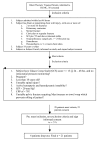Evaluation of the safety of high-frequency chest wall oscillation (HFCWO) therapy in blunt thoracic trauma patients
- PMID: 18837992
- PMCID: PMC2569011
- DOI: 10.1186/1752-2897-2-8
Evaluation of the safety of high-frequency chest wall oscillation (HFCWO) therapy in blunt thoracic trauma patients
Abstract
Background: Airway clearance is frequently needed by patients suffering from blunt chest wall trauma. High Frequency Chest Wall Oscillation (HFCWO) has been shown to be effective in helping to clear secretions from the lungs of patients with cystic fibrosis, bronchiectasis, asthma, primary ciliary dyskinesia, emphysema, COPD, and many others. Chest wall trauma patients are at increased risk for development of pulmonary complications related to airway clearance. These patients frequently have chest tubes, drains, catheters, etc. which could become dislodged during HFCWO. This prospective observational study was conducted to determine if HFCWO treatment, as provided by The Vesttrade mark Airway Clearance System (Hill-Rom, Saint Paul, MN), was safe and well tolerated by these patients.
Methods: Twenty-five blunt thoracic trauma patients were entered into the study. These patients were consented. Each patient was prescribed 2, 15 minute HFCWO treatments per day using The Vest(R) Airway Clearance System (Hill-Rom, Inc., St Paul, MN). The Vest(R) system was set to a frequency of 10-12 Hz and a pressure of 2-3 (arbitrary unit). Physiological parameters were measured before, during, and after treatment. Patients were free to refuse or terminate a treatment early for any reason.
Results: No chest tubes, lines, drains or catheters were dislodged as a result of treatment. One patient with flail chest had a chest tube placed after one treatment due to increasing serous effusion. No treatments were missed and continued without further incident. Post treatment survey showed 76% experienced mild or no pain and more productive cough. Thirty days after discharge there were no deaths or hospital re-admissions.
Conclusion: This study suggests that HFCWO treatment is safe for trauma patients with lung and chest wall injuries. These findings support further work to demonstrate the airway clearance benefits of HFCWO treatment.
Figures


References
-
- Xirouchaki N, Kondoudaki E, et al. Noninvasive bilevel positive pressure ventilation in patients with blunt thoracic trauma. Respiration. 2005;72:517–522. - PubMed
-
- Nakagawa NK, Franchini ML, Driusso P, de Oliveira LR, Saldiva PHN, Lorenzi-Filho G. Mucociliary clearance is impaired in acutely ill patients. CHEST. 2005;128:2772–2777. - PubMed
LinkOut - more resources
Full Text Sources

